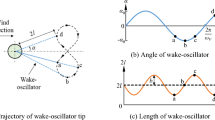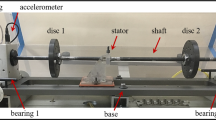Abstract
A computational model is developed to obtain a helicopter rotor blade's vibration characteristics and aerodynamic behavior. A mathematical model of the wake is also developed, consisting of fundamental wake geometry. A Bo 105 helicopter rotor blade is considered for computational aerodynamic analysis. A fluid–structure interaction model of the rotor blade with surrounding air is developed, where the finite element model of the blade is coupled with the computational fluid dynamics model of the surrounding air. The fluid–structure interaction model analyzes aerodynamic coefficients, velocity profiles, and pressure profiles. The resonance frequencies and mode shapes are also obtained by the computational method. A small-scale model of the rotor blade is manufactured, and experimental analysis of similar contemplation is conducted to validate the numerical results. Wind tunnel and vibration testing arrangements are used for the experimental validation of the aerodynamic and vibration characteristics, respectively. The wake and vortex analysis showed that the swirl velocity is minimum, and the axial velocity is maximum at the vortex center. The axial velocity decreases, and swirl velocity increases with increasing the distance from the vortex center to the core radius. Finally, an application of experimentally validated computational methodology for helicopter rotor blade to evaluate aerodynamic characteristics in a fluid–structure interaction environment along with the characterization of resonance properties is outlined where the results follow an expected pattern.























Similar content being viewed by others
Abbreviations
- \({C}_{{\text{L}}}\) :
-
Coefficient of lift
- \({C}_{{\text{D}}}\) :
-
Coefficient of drag
- \(V\) :
-
Velocity
- \({V}_{x}\) :
-
Velocity in \(x\)-direction
- \({V}_{y}\) :
-
Velocity in \(y\)-direction
- \({V}_{z}\) :
-
Velocity in \(z\)-direction
- \({V}_{\infty }\) :
-
Freestream velocity
- \(U\) :
-
Deformation
- \({U}_{x}\) :
-
Deformation in \(x\)-direction
- \({U}_{y}\) :
-
Deformation in \(y\)-direction
- \({U}_{z}\) :
-
Deformation in \(z\)-direction
- \(\alpha\) :
-
Angle of attack
- \(\psi\) :
-
Azimuth angle
- \(E\) :
-
Modulus of elasticity
- \(\rho\) :
-
Density
- \(\nu\) :
-
Poisson’s ratio
- \(\mu\) :
-
Dynamic viscosity
- \(L\) :
-
Characteristic length
- \(l\) :
-
Length of the rotor blade
- \(c\) :
-
Chord length of the airfoil
- \(\overrightarrow{u}\) :
-
Flow velocity vector
- \({\overrightarrow{u }}_{g}\) :
-
Mesh velocity of the moving mesh
- \(\Gamma\) :
-
Diffusion coefficient
- \({V}_{\theta }\) :
-
Tangential or swirl velocity
- \({V}_{z}\) :
-
Axial velocity
- \({V}_{r}\) :
-
Radial velocity
- \({\Gamma }_{v}\) :
-
Vortex strength
- \(\overline{r }\) :
-
Nondimensional radius
- \(r\) :
-
Radial location
- \({r}_{{\text{c}}}\) :
-
Vortex core radius
- \(\alpha\) :
-
Constant
- \(n\) :
-
Integer
- \(\overrightarrow{\omega }\) :
-
Vorticity vector
- \(\overrightarrow{V}\) :
-
Local velocity field
- \(\overrightarrow{r}\) :
-
Position vector
- \(t\) :
-
Time
- \({\psi }_{\omega }\) :
-
Wake age
- \({\psi }_{b}\) :
-
Azimuth angle
- \(\Omega\) :
-
Rotation
- \({\overrightarrow{V}}_{{\text{loc}}}\) :
-
Local velocity
- \({\overrightarrow{V}}_{{\text{ind}}}\) :
-
Induced velocity
- \({\psi }_{j}\) :
-
Location coordinate of jth vortex
- \({z}_{{\text{tip}}}\) :
-
Axial displacement
- \({y}_{{\text{tip}}}\) :
-
Radial displacement
- \(R\) :
-
Maximum displacement
- \({k}_{1}, {k}_{2}, {C}_{T}\) :
-
Empirical coefficients in the wake models
- \({N}_{{\text{b}}}\) :
-
Number of blade
- \({\theta }_{{\text{tw}}}\) :
-
Blade twist
- \(\Lambda\) :
-
Coefficient for the radial contraction
- \(A\) :
-
Constant
- \(B, C, m, n\) :
-
Empirical coefficients in the Kocurek and Tanglers wake model
- \(\lambda\) :
-
Contraction rate parameter
- \({S}_{\phi }\) :
-
Source term of \(\phi\)
- \({\text{Re}}\) :
-
Reynolds number
- \(\partial V\) :
-
Boundary of the control volume \(V\)
References
Zhou, X., He, S., Dong, L., Atluri, S.N.: Real-time prediction of probabilistic crack growth with a helicopter component digital twin. AIAA J. 60(4), 2555–2567 (2022). https://doi.org/10.2514/1.J060890
Kang, Y., Cao, S., Hou, Y., You, Z., Ma, Q.: Analysis of backward whirl characteristics of rubbing dual-rotor systems. Acta Mech. 46, 1–31 (2023). https://doi.org/10.1007/s00707-023-03660-w
Bardera Mora, R., Matías García, J.C.: Helicopter rotor ground effect and frigate interaction investigated by particle image velocimetry. AIAA J. 60(1), 129–143 (2022). https://doi.org/10.2514/1.J060439
Sarker, P., Chakravarty, U.K.: On the dynamic response of a hingeless helicopter rotor blade. Aerosp. Sci. Technol. 115, 106741 (2021). https://doi.org/10.1016/j.ast.2021.106741
Patterson, R.P., Friedmann, P.P.: Vibration reduction on helicopter rotors using open-loop flow control. AIAA J. 60(1), 113–128 (2022). https://doi.org/10.2514/1.J060717
Bramewell, A.R.S., Balmford, D., Done, G.: Bramewell’s Helicopter Dynamics. Elsevier, Amsterdam (2001)
Aksencer, T., Aydogdu, M.: Flapwise vibration of rotating composite beams. Compos. Struct. 134, 672–679 (2015). https://doi.org/10.1016/j.compstruct.2015.08.130
Hodges, D.H., Ormiston, R.A.: Stability of elastic bending and torsion of uniform cantilever rotor blades in hover with variable structural coupling. NASA Technical Note D-8192, 1976, Ames Research center, California, USA. https://ntrs.nasa.gov/api/citations/19760014074/downloads/19760014074.pdf
Hodges, D.H., Atilgan, A.R., Fulton, M.V., Rehfield, L.W.: Free-vibration analysis of composite beams. J. Am. Helicopter Soc. 36(3), 36–47 (1991). https://doi.org/10.4050/JAHS.36.36
Ho, J.C., Yeo, H.: Assessment of comprehensive analysis predictions of helicopter rotor blade loads in forward flight. J. Fluids Struct. 68, 194–223 (2017). https://doi.org/10.1016/j.jfluidstructs.2016.09.007
Walsh, J.L., Bingham, G.J., Riley, M.F.: Optimization methods applied to the aerodynamic design of helicopter rotor blades. J. Am. Helicopter Soc. 32(4), 39–44 (1987). https://doi.org/10.4050/JAHS.32.39
Koning, W.J., Johnson, W., Grip, H.F.: Improved mars helicopter aerodynamic rotor model for comprehensive analyses. AIAA J. 57(9), 3969–3979 (2019). https://doi.org/10.2514/1.J058045
Weiss, A., Gardner, A.D., Schwermer, T., Klein, C., Raffel, M.: On the effect of rotational forces on rotor blade boundary-layer transition. AIAA J. 57(1), 252–266 (2019). https://doi.org/10.2514/1.J057036
Uluocak, S., Perçin, M., Uzol, O.: Experimental investigation of tip anhedral effects on the aerodynamics of a model helicopter rotor in hover. Aerosp. Sci. Technol. 113, 106671 (2021). https://doi.org/10.1016/j.ast.2021.106671
Bailly, J., Bailly, D.: Multifidelity aerodynamic optimization of a helicopter rotor blade. AIAA J. 57(8), 3132–3144 (2019). https://doi.org/10.2514/1.J056513
Samad, A., Villeneuve, E., Morency, F., Volat, C.: A numerical and experimental investigation of the convective heat transfer on a small helicopter rotor test setup. Aerospace 8(2), 53 (2021). https://doi.org/10.3390/aerospace8020053
Pulok, M.K.H., Chakravarty, U.K.: A study of the aerodynamics of a helicopter rotor blade. In: Proc. of ASME International Mechanical Engineering Congress and Exposition, Saltlake City, UT, USA, IMECE2019-11477, pp. 1–9 (2019). https://doi.org/10.1115/IMECE2019-11477
Pulok, M.K.H., Chakravarty, U.K.: An investigation of the aerodynamic and vibration behavior of a helicopter rotor blade. In: Proc. of ASME International Mechanical Engineering Congress and Exposition, Virtual, Online, IMECE2020-23668, pp. 1–11 (2020). https://doi.org/10.1115/IMECE2020-23668
Hoseini, H.S., Hodges, D.H.: Aeroelastic stability analysis of damaged high-aspect-ratio composite wings. J. Aircr. 56(5), 1794–1808 (2019). https://doi.org/10.2514/1.C035098
Yang, X., Yang, A., Si, J.: Efficient numerical techniques for simulating a rotorcraft flow field with overlapping grids. AIAA J. 53(5), 1372–1383 (2015). https://doi.org/10.2514/1.J053426
Wirth, N., Bayrasy, P., Landvogt, B., Wolf, K., Cecutti, F., Lewandowski, T.: Analysis and optimization of flow around flexible wings and blades using the standard co-simulation interface MpCCI. In: Recent Progress in Flow Control for Practical Flows, pp. 283–321. Springer, Cham (2017). https://doi.org/10.1007/978-3-319-50568-8_15
Cook, J.R., Smith, M.J., Thepvongs, S., Cesnik, C.E.: Computational aeroelasticity of rotating wings with deformable airfoils. J. Am. Helicopter Soc. 62(3), 14–26 (2017). https://doi.org/10.4050/JAHS.62.032006
Wang, X., Trollinger, L., Chopra, I.: Refined performance results on a slowed mach-scaled rotor at high advance ratios. J. Am. Helicopter Soc. 65(1), 1–13 (2020). https://doi.org/10.4050/JAHS.65.012003
Riyad, I.A., Chakravarty, U.K.: An analysis of harmonic airloads acting on helicopter rotor blades. In: Proc. of the ASME International Mechanical Engineering Congress and Exposition, Pittsburg, PA, USA, IMECE2018-86625, pp. 1–11 (2018). https://doi.org/10.1115/IMECE2018-86625
McAlister, K.W.: Rotor wake development during the first revolution. J. Am. Helicopter Soc. 49(4), 371–390 (2004). https://doi.org/10.4050/JAHS.49.371
Schwarz, C., Bauknecht, A., Mailänder, S., Raffel, M.: Wake characterization of a free-flying model helicopter in ground effect. J. Am. Helicopter Soc. 64(1), 1–16 (2019). https://doi.org/10.4050/JAHS.64.012010
Schwarz, C., Bauknecht, A., Wolf, C.C., Coyle, A., Raffel, M.: A full-scale rotor-wake investigation of a free-flying helicopter in ground effect using BOS and PIV. J. Am. Helicopter Soc. 65(3), 1–20 (2020). https://doi.org/10.4050/JAHS.65.032007
Wolf, C.C., Schwarz, C., Kaufmann, K., Gardner, A.D., Michaelis, D., Bosbach, J., Schanz, D., Schröder, A.: Experimental study of secondary vortex structures in a rotor wake. Exp. Fluids 60(11), 1–16 (2019). https://doi.org/10.1007/s00348-019-2807-1
Van der Wall, B.G., Van der Wall, L.B.: Analytical estimate of rotor controls required for a straight vortex disturbance rejection. J. Am. Helicopter Soc. 62(1), 1–4 (2017). https://doi.org/10.4050/JAHS.62.015001
Venegas, E.D., Rieu, P., Le Dizès, S.: Structure and stability of Joukowski’s rotor wake model. J. Fluid Mech. 911(A6), 1–26 (2021). https://doi.org/10.1017/jfm.2020.985
Singh, P., Friedmann, P.P.: Application of vortex methods to coaxial rotor wake and load calculations in hover. J. Aircr. 55(1), 373–381 (2018). https://doi.org/10.2514/1.C034520
Qi, H., Xu, G., Lu, C., Shi, Y.: A study of coaxial rotor aerodynamic interaction mechanism in hover with high-efficient trim model. Aerosp. Sci. Technol. 84, 1116–1130 (2019). https://doi.org/10.1016/j.ast.2018.11.053
Stratasys Ltd., Eden Prairie, Minnesota, USA
Data Physics Corporation, San Jose, California, USA
Dytran Instruments INC., Chatsworth, California, USA
Photron, San Diego, California, USA
Correlated Solutions, Inc., Irmo, South Carolina, USA
VIC-Snap., Version 7.8, Correlated Solutions, Inc., Irmo, South Carolina, USA (2014)
VIC-3D., Version 7.2.4, Correlated Solutions, Inc., Irmo, South Carolina, USA (2014)
Bracewell, R.N.: The Fourier Transform and Its Applications, 1st edn. McGraw-Hill, New York (1986)
GDJ INC., Mentor, Ohio, USA
Aerolab LLC, Jessup, Maryland, USA
TSI Incorporated, Shoreview, Minnesota, USA
Ansys Inc., Canonsburg, Pennsylvania
Goerttler, A., Braukmann, J.N., Schwermer, T., Gardner, A.D., Raffel, M.: Tip-vortex investigation on a rotating and pitching rotor blade. J. Aircr. 55(5), 1792–1804 (2018). https://doi.org/10.2514/1.C034693
Leishman, J.G.: Principles of Helicopter Aerodynamics. Cambridge University Press, Cambridge (2006)
Vatistas, G.H., Kozel, V., Mih, W.C.: A simpler model for concentrated vortices. Exp. Fluids 11(1), 73–76 (1991). https://doi.org/10.1007/BF00198434
Pulok, M.K.H., Chakravarty, U.K.: Modal characterization, aerodynamics, and gust response of an electroactive membrane. AIAA J. 60(5), 1–12 (2022). https://doi.org/10.2514/1.J060997
White, J.R., Adams, D.E., Rumsey, M.A.: Modal analysis of cx-100 rotor blade and micon 65/13 wind turbine, structural dynamics and renewable energy. In: Conference Proceedings of the Society for Experimental Mechanics Series, vol. 1, pp. 15–27. Springer, New York (2011). https://doi.org/10.1007/978-1-4419-9716-6_2
Acknowledgements
The authors would like to thank Dr. William Warmbrodt, who was the NASA technical monitor for the work presented in this paper. The authors are also thankful to Taylor Weidman, a Mechanical Engineering Technician of the College of Engineering at the University of New Orleans, for his support in conducting the laboratory experiments.
Funding
This research was supported by the NASA EPSCoR Research Infrastructure Development (RID) grant (Contract No. LEQSF-EPS (2020)-RAP-29).
Author information
Authors and Affiliations
Corresponding author
Ethics declarations
Conflict of interest
The authors have no relevant financial or non-financial interests to disclose.
Additional information
Publisher's Note
Springer Nature remains neutral with regard to jurisdictional claims in published maps and institutional affiliations.
Rights and permissions
Springer Nature or its licensor (e.g. a society or other partner) holds exclusive rights to this article under a publishing agreement with the author(s) or other rightsholder(s); author self-archiving of the accepted manuscript version of this article is solely governed by the terms of such publishing agreement and applicable law.
About this article
Cite this article
Pulok, M.K.H., Chakravarty, U.K. Aerodynamics and vibration analysis of a helicopter rotor blade. Acta Mech 235, 3033–3057 (2024). https://doi.org/10.1007/s00707-024-03871-9
Received:
Revised:
Accepted:
Published:
Issue Date:
DOI: https://doi.org/10.1007/s00707-024-03871-9




